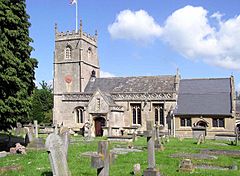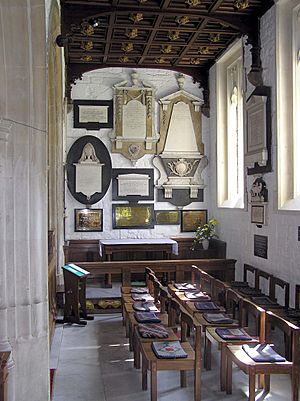Church of St Nicholas, Bathampton facts for kids
Quick facts for kids Church of St Nicholas |
|
|---|---|
 |
|
| Location | Bathampton, Somerset. |
| Website | stnicholasbathampton.org |
|
Listed Building – Grade II*
|
|
| Designated | 1 February 1956 |
| Reference no. | 1320551 |
| Lua error in Module:Location_map at line 420: attempt to index field 'wikibase' (a nil value). | |
The Church of St Nicholas is an Anglican church located in Bathampton, Somerset, England. It stands beautifully between the River Avon and the Kennet and Avon Canal. This historic church was first built in the 13th century. It has been changed and updated many times since then, with a tower added in the 15th century and more work done in the 1700s and 1800s. Because of its special history and architecture, it is recognized as a Grade II* listed building.
One of the most interesting parts of the church is its Australia Chapel. This chapel remembers Admiral Arthur Phillip, who was the first Governor of New South Wales in Australia. He was buried here in 1814. The churchyard also has several other important tombs. The church is part of the local group of churches that includes Bathampton and Claverton.
Contents
History of the Church
Early Beginnings
The land where the church stands was given to Bath Abbey around the year 940 by King Edmund I. However, the first church building probably appeared after the Norman Conquest in 1066. On the outside wall of the chancel (the area around the altar), you can see a stone carving. It likely shows Saint Nicholas, who the church is named after. He is shown wearing clothes from the late 1000s.
It is thought that the church originally had a tower in the middle. Some old features, like a piscina (a basin for washing sacred vessels) and a cross on the roof, were still there in the 1800s. We don't have many early records, but the first vicar (church leader) was recorded in 1261. The Black Death, a terrible sickness in the 1300s, greatly affected the church. Five different vicars served the parish between 1348 and 1349, and many of them likely died from the plague.
During the 1400s, the church was changed. A new chapel was added in 1500, and the tower was built in 1532.
Changes During the Reformation
The Reformation was a time in the 1500s when the church in England changed from Roman Catholicism to Anglicanism. This period had different effects on the Church of St Nicholas. The vicar, Richard Gibbons, served for a long time, from 1527 to 1567, through all these big changes. The church bells, made in 1540, were named after St Thomas and St Lucy.
In 1539, the ownership of the church moved from Bath Abbey to Bristol Cathedral, where it still is today. During this time, two small statues were hidden in the chancel wall. They were only found many centuries later. Even when Queen Mary I briefly brought England back to Catholicism, the church had already gotten rid of its Catholic service books. Not much happened for the next two hundred years, except that the churches of Bathampton and Bathford were joined together around 1663.
Rebuilding and Expansion
In 1754-5, Ralph Allen, who owned Bathampton Manor, rebuilt most of the church in a Gothic style. He added a family chapel next to the main part of the church. During this work, many old medieval parts were lost. Statues of a knight and his lady from the late 1300s were moved to the churchyard. This might also explain why the old medieval font (a basin for baptisms) is now outside the porch.
When Rev'd E.D. Rhodes became vicar in 1855, Bathampton church became separate from Bathford again. The church was then restored and made bigger. A north aisle (a side section) and a small vestry (a room for clergy) were added in 1858 by Major C.E. Davis. An organ room was built in 1879, a south aisle and a new porch in 1882, and the vestry was made larger in 1897.
In 1904, a cross was put up in the churchyard to celebrate the Coronation of King Edward VII. Since then, plaques have been added to it for every coronation and jubilee. Near the main door, there are memorials to the villagers who died in World War I and World War II.
The Australia Chapel
In 1974, the South Aisle, which used to be the Allen Chapel, was updated to become the Australia Chapel. This was done to honor Admiral Arthur Phillip, the first Governor of New South Wales, Australia, who was buried here in 1814. The chapel now has a floor made of Australian Wombeyan Marble. It also features a special screen made of Australian Blackbean wood. The kneelers (cushions for kneeling) are from Tasmania, and the stained glass windows show the coats of arms of the Australian Federal Government and all six Australian states.
The chapel was officially opened in 1975 by Bishop E.B. Henderson. Every year, around October 11th (Arthur Phillip’s birthday), a special service is held to remember his life. During this service, the Australian High Commissioner places a wreath on his grave.
Notable Burials
Many interesting people are buried in the churchyard. One is Adolphe, Viscount du Barry, a relative of Madame du Barry. He died after an argument with his acquaintance Captain Rice.
Other important local figures, such as William Harbutt, Kenneth Murchison, and Walter Sickert, are also buried here. Many of the chest tombs (large stone tombs) in the churchyard are also recognized as listed buildings.
Church Leaders
Many vicars have served the Church of St Nicholas over the centuries, with records going back to 1261. These leaders have guided the church community through many historical changes and played an important role in the life of Bathampton.
The Church Today
The Church of St Nicholas holds public services every Sunday at 10:45 am. There are special groups for children and youth, and services are also available online using Zoom. The church is very involved in the local community. It hosts "The Bridge," a Thursday morning group where people of all ages can meet. There are also mid-week home-groups for studying the Bible.
See also
- List of ecclesiastical parishes in the Diocese of Bath and Wells


